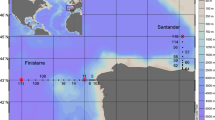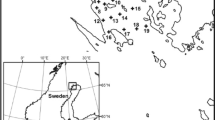Abstract
Bacterial production is one of the key parameters to evaluate bacterial role in ocean carbon fluxes. Estimation of bacterial production requires the leucine-to-carbon conversion factors that change widely across environments. However, empirical leucine-to-carbon conversion factors (eCFs) are seldom determined in situ because of time consuming and little is known on regulating factors for the eCFs. During May 2015 to January 2016, fourteen dilution experiments were conducted, from the Zhujiang (Pearl River) Estuary to the coast of the northern South China Sea, to determine spatiotemporal variability in the eCFs and its potential controlling factors along an environmental gradient. The eCFs showed clear spatial variations with the highest (1.27–1.69 (kg C)/(mol Leu)) in low salinity waters (salinity<15), intermediate (1.03–1.25 (kg C)/(mol Leu)) in moderate salinity (salinity of 15–25), and the lowest (0.48–0.85 (kg C)/(mol Leu)) in high salinity waters (salinity>25). Substrate availability was responsible for spatial variability in the eCFs. In the pristine coastal waters, low eCFs was related to substrate limitation and leucine incorporated was respired to maximize the survival rather than bacterial production. Hence, the eCFs measurement was needed for estimating bacterial production accurately in various marine environments.
Similar content being viewed by others
References
Agusti S, Duarte C M, Vaque D, et al. 2001. Food-web structure and elemental (C, N and P) fluxes in the eastern tropical North Atlantic. Deep-Sea Research Part II, 48: 2295–2321
Alonso-Sáez L, Gasol J M, Arístegui J, et al. 2007. Large-scale variability in surface bacterial carbon demand and growth efficiency in the subtropical northeast Atlantic Ocean. Limnology and Oceanography, 52(2): 533–546
Alonso-Sáez L, Pinhassi J, Pernthaler J, et al. 2010. Leucine-to-carbon empirical conversion factor experiments: does bacterial community structure have an influence?. Environmental Microbiology, 12(11): 2988–2997
Baptista I, Santos A L, Cunha Â, et al. 2011. Bacterial biomass production in an estuarine system: high variability of leucine conversion factors and changes in bacterial community structure during incubation. Aquatic Microbial Ecology, 62(3): 299–310
Carlson C A, del Giorgio P A, Herndl G J. 2007. Microbes and the dissipation of energy and respiration: from cells to ecosystems. Oceanography, 20(2): 89–100
Dai Minghan, Guo Xianghui, Zhai Weidong, et al. 2006. Oxygen depletion in the upper reach of the Pearl River estuary during a winter drought. Marine Chemistry, 102(1–2): 159–169
Dai Minghan, Zhai Weidong, Cai Weijun, et al. 2008. Effects of an estuarine plume-associated bloom on the carbonate system in the lower reaches of the Pearl River estuary and the coastal zone of the northern South China Sea. Continental Shelf Research, 28(12): 1416–1423
del Giorgio P A, Condon R, Bouvier T, et al. 2011. Coherent patterns in bacterial growth, growth efficiency, and leucine metabolism along a northeastern Pacific inshore-offshore transect. Limnology and Oceanography, 56(1): 1–16
Ducklow H W, Kirchman D L, Quinby H L. 1992. Bacterioplankton cell growth and macromolecular synthesis in seawater cultures during the North Atlantic Spring Phytoplankton Bloom, May, 1989. Microbial Ecology, 24(2): 125–144
Franco-Vidal L, Morán X A G. 2011. Relationships between coastal bacterioplankton growth rates and biomass production: comparison of leucine and thymidine uptake with single-cell physiological characteristics. Microbial Ecology, 61(2): 328–341
Fuhrman J A, Azam F. 1980. Bacterioplankton secondary production estimates for coastal waters of British Columbia, Antarctica, and California. Applied and Environmental Microbiology, 39(6): 1085–1095
Fuhrman J. 1992. Bacterioplankton roles in cycling of organic matter: the microbial food web. In: Falkowski P G, Woodhead A D, Vivirito K, eds. Primary Productivity and Biogeochemical Cycles in the Sea. New York: Plenum, 361–383
Grasshoff K, Kremling K, Ehrhardt M. 1999. Methods of Seawater Analysis. 3rd ed. Weinheim: WILEY-VCH Verlag GmbH, 159–226
He Biyan, Dai Minghan, Zhai Weidong, et al. 2010. Distribution, degradation and dynamics of dissolved organic carbon and its major compound classes in the Pearl River estuary, China. Marine Chemistry, 119(1–4): 52–64
Kirchman D, K’Nees E, Hodson R. 1985. Leucine incorporation and its potential as a measure of protein synthesis by bacteria in natural aquatic systems. Applied and Environmental Microbiology, 49(3): 599–607
Kirchman D L, Ducklow H W. 1993. Estimating conversion factors for the thymidine and leucine methods for measuring bacterial production. In: Kemp P F, Sherr B F, Sherr E B, et al., eds. Handbook of Methods in Aquatic Microbial Ecology. Boca Raton, FL: Lewis Publishing, 513–517
Knap A H, Michaels A, Close A R, et al. 1996. Protocols for the joint global ocean flux study (JGOFS) core measurements. JGOFS Report NO. 19. Reprint of the IOC Manuals and Guides No. 29. Paris: UNESCO
Lee S, Fuhrman J A. 1987. Relationships between biovolume and biomass of naturally derived marine bacterioplankton. Applied and Environmental Microbiology, 53(6): 1298–1303
Li Q P, Hansell D A. 2008. Nutrient distributions in baroclinic eddies of the oligotrophic North Atlantic and inferred impacts on biology. Deep Sea Research Part II: Topical Studies in Oceanography, 55(10): 1291–1299
Li Q P, Hansell D A, Zhang J Z. 2008. Underway monitoring of nanomolar nitrate plus nitrite and phosphate in oligotrophic seawater. Limnology and Oceanography: Methods, 6(7): 319–326
Mandelstam J. 1958. Turnover of protein in growing and non-growing populations of Escherichia coli. Biochemical Journal, 69(1): 110–119
Marie D, Partensky F, Jacquet S, et al. 1997. Enumeration and cell cycle analysis of natural populations of marine picoplankton by flow cytometry using the nucleic acid stain SYBR Green I. Applied and Environmental Microbiology, 63(1): 186–193
McManus G B, Fuhrman J A. 1988. Control of marine bacterioplankton populations: measurement and significance of grazing. Hydrobiologia, 159(1): 51–62
Morán X A G, Fernández E, Pérez V. 2004. Size-fractionated primary production, bacterial production and net community production in subtropical and tropical domains of the oligotrophic NE Atlantic in autumn. Marine Ecology Progress Series, 274: 17–29
Parsons T R, Maita Y, Lalli C M. 1984. A Manual of Chemical and Biological Methods for Seawater Analysis. Oxford: Pergamum Press
Pulido-Villena E, Reche I. 2003. Exploring bacterioplankton growth and protein synthesis to determine conversion factors across a gradient of dissolved organic matter. Microbial Ecology, 46(1): 33–42
Servais P. 1990. Estimation of bacterial production in marine ecosystems from the measurement of the protein-synthesis rate. Oceanologic Acta (in French), 13(8): 229–235
Simon M, Azam F. 1989. Protein content and protein synthesis rates of planktonic marine bacteria. Marine Ecology Progress Series, 51(3): 201–213
Smith D C, Azam F. 1992. A simple, economical method for measuring bacterial protein synthesis rates in seawater using 3H-leucine. Marine Microbial Food Webs, 6(2): 107–114
Teira E, Hernando-Morales V, Cornejo-Castillo F M, et al. 2015. Sample dilution and bacterial community composition influence empirical leucine-to-carbon conversion factors in surface waters of the world’s oceans. Applied and Environmental Microbiology, 81(23): 8224–8232
Xu Jie, Jing Hongmei, Sun Mingming, et al. 2013. Regulation of bacterial metabolic activity by dissolved organic carbon and viruses. Journal of Geophysical Reseach: Biogeosciences, 118(4): 1573–1583
Xu Jie, Yin Kedong, He Lei, et al. 2008. Phosphorus limitation in the northern South China Sea during late summer: influence of the Pearl River. Deep Sea Research Part I: Oceanographic Research Papers, 55(10): 1330–1342
Yin Kedong, Qian Peiyuan, Wu M C S, et al. 2001. Shift from P to N limitation of phytoplankton growth across the Pearl River estuarine plume during summer. Marine Ecology Progess Series, 221: 17–28
Author information
Authors and Affiliations
Corresponding author
Additional information
Foundation item: The National Key Research and Development Program under contract No. 2016YFA0601203; the National Natural Science Foundation of China under contract Nos 41476137 and 41676075; the Project of State Key Laboratory of Tropical Oceanography under contract No. LTOZZ1504-1; the Hundred Talent Program of Chinese Academy of Sciences under contract No. Y35L041001.
Rights and permissions
About this article
Cite this article
Li, X., Xu, J., Shi, Z. et al. Variability in the empirical leucine-to-carbon conversion factors along an environmental gradient. Acta Oceanol. Sin. 37, 77–82 (2018). https://doi.org/10.1007/s13131-018-1144-1
Received:
Accepted:
Published:
Issue Date:
DOI: https://doi.org/10.1007/s13131-018-1144-1




